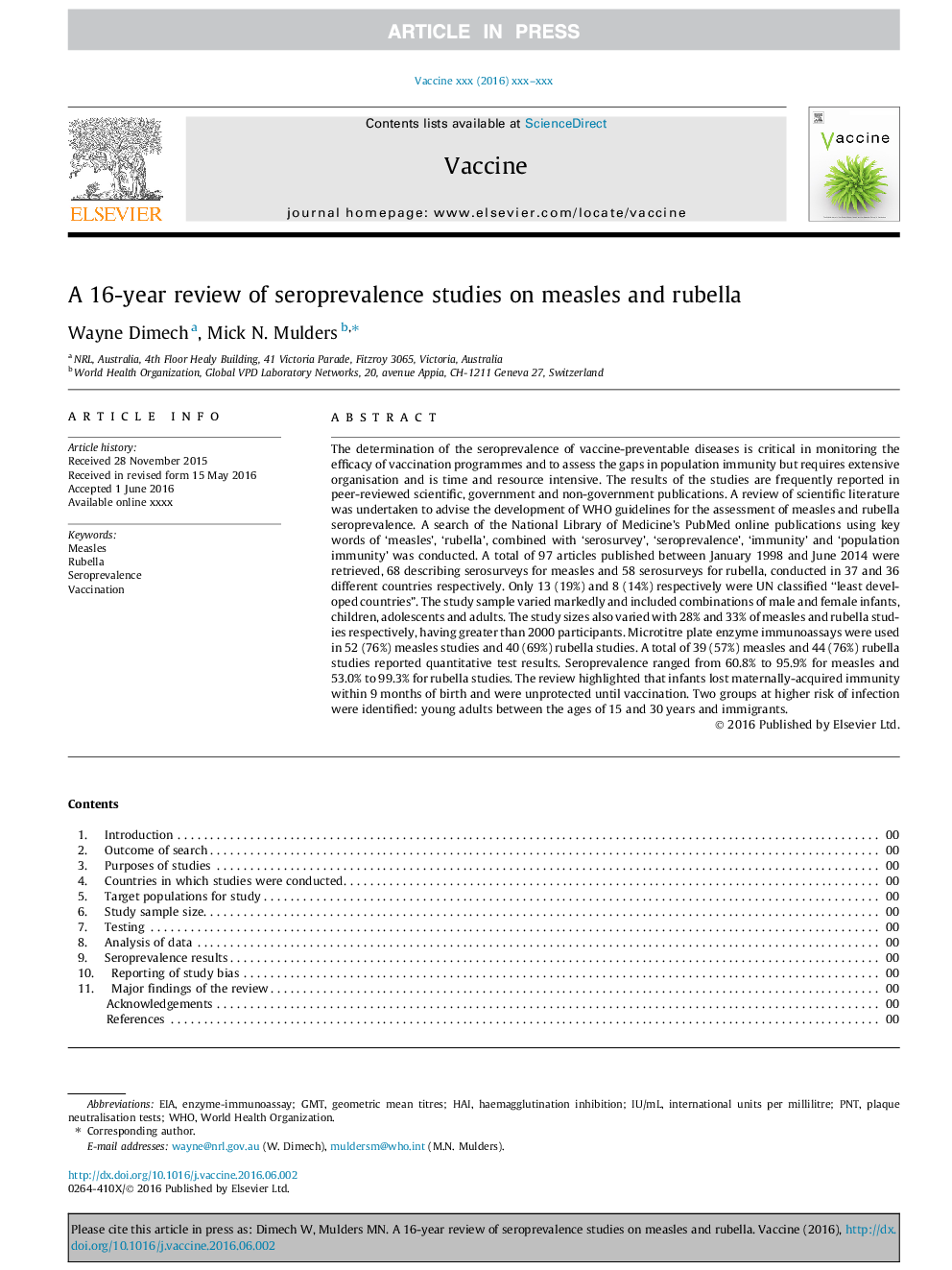| کد مقاله | کد نشریه | سال انتشار | مقاله انگلیسی | نسخه تمام متن |
|---|---|---|---|---|
| 10962453 | 1102637 | 2016 | 9 صفحه PDF | دانلود رایگان |
عنوان انگلیسی مقاله ISI
A 16-year review of seroprevalence studies on measles and rubella
ترجمه فارسی عنوان
بررسی 16 ساله مطالعات سرولوژیکی سرخک و سرخجه
دانلود مقاله + سفارش ترجمه
دانلود مقاله ISI انگلیسی
رایگان برای ایرانیان
کلمات کلیدی
GMTHAIPNTIU/ml - IU / میلی لیترEnzyme-immunoassay - آنزیم ایمونوآنتیEIA - اینWorld Health Organization - سازمان بهداشت جهانیrubella - سرخچهSeroprevalence - سرولوژیMeasles - سُرخَک haemagglutination inhibition - مهار hemagglutinationgeometric mean titres - میانگین تیترهای هندسیVaccination - واکسیناسیونWHO - که
موضوعات مرتبط
علوم زیستی و بیوفناوری
ایمنی شناسی و میکروب شناسی
ایمونولوژی
چکیده انگلیسی
The determination of the seroprevalence of vaccine-preventable diseases is critical in monitoring the efficacy of vaccination programmes and to assess the gaps in population immunity but requires extensive organisation and is time and resource intensive. The results of the studies are frequently reported in peer-reviewed scientific, government and non-government publications. A review of scientific literature was undertaken to advise the development of WHO guidelines for the assessment of measles and rubella seroprevalence. A search of the National Library of Medicine's PubMed online publications using key words of 'measles', 'rubella', combined with 'serosurvey', 'seroprevalence', 'immunity' and 'population immunity' was conducted. A total of 97 articles published between January 1998 and June 2014 were retrieved, 68 describing serosurveys for measles and 58 serosurveys for rubella, conducted in 37 and 36 different countries respectively. Only 13 (19%) and 8 (14%) respectively were UN classified “least developed countries”. The study sample varied markedly and included combinations of male and female infants, children, adolescents and adults. The study sizes also varied with 28% and 33% of measles and rubella studies respectively, having greater than 2000 participants. Microtitre plate enzyme immunoassays were used in 52 (76%) measles studies and 40 (69%) rubella studies. A total of 39 (57%) measles and 44 (76%) rubella studies reported quantitative test results. Seroprevalence ranged from 60.8% to 95.9% for measles and 53.0% to 99.3% for rubella studies. The review highlighted that infants lost maternally-acquired immunity within 9Â months of birth and were unprotected until vaccination. Two groups at higher risk of infection were identified: young adults between the ages of 15 and 30Â years and immigrants.
ناشر
Database: Elsevier - ScienceDirect (ساینس دایرکت)
Journal: Vaccine - Volume 34, Issue 35, 29 July 2016, Pages 4110-4118
Journal: Vaccine - Volume 34, Issue 35, 29 July 2016, Pages 4110-4118
نویسندگان
Wayne Dimech, Mick N. Mulders,
